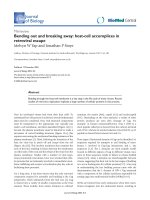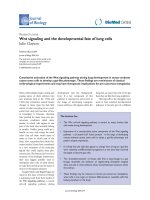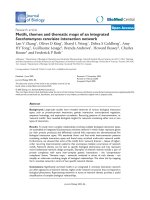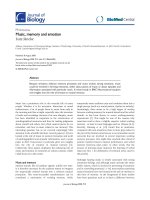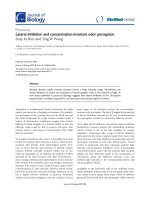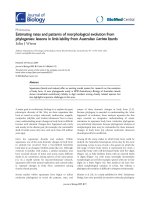Báo cáo sinh học: "Clocks, cryptochromes and Monarch migrations" pot
Bạn đang xem bản rút gọn của tài liệu. Xem và tải ngay bản đầy đủ của tài liệu tại đây (1.72 MB, 4 trang )
Minireview
CClloocckkss,, ccrryyppttoocchhrroommeess aanndd MMoonnaarrcchh mmiiggrraattiioonnss
Charalambos P Kyriacou
Address: Department of Genetics, University of Leicester, Leicester LE1 7RH, UK. Email:
At the approach of fall in the northern United States and
southern Canada, the Monarch butterfly, Danaus plexippus
(Figure 1), starts to get restless. These butterflies usually
represent the third or fourth generation that season, each
previous generation having lived for around 6-8 weeks. The
current generation senses the shorter photoperiod of autumn
days and starts to shut down its reproductive system, lay down
extra layers of fat, and in general become more physiologically
resistant to environmental stresses such as colder tempera-
tures. This state of diapause precedes one of nature’s most
glorious sights, the annual autumn migration of the Monarch
from the northern United States to its overwintering grounds
in central Mexico, where it settles in oyamel fir trees [1]. This
alteration in the Monarch’s physiological state, in readiness for
the arduous 4,000-kilometer journey south, includes a three-
to fourfold increase in longevity that will carry these
individuals through to the following spring in Mexico. At that
time they mate, lay the fertilized eggs on milkweed (Asclepias),
and the few adults that survive begin their northern journey
home. In two or three generations, each one laying eggs
progressively further north as milkweed starts into new
growth, the Monarchs finally reach their northern homes. In
the autumn, the cycle begins again [1].
BBuutttteerrffllyy mmiiggrraattiioonn aanndd tthhee cciirrccaaddiiaann cclloocckk
This remarkable feat represents the longest annual insect
migration known and has become a focus of study for the
circadian biologist Steven Reppert and his group at the
University of Massachusetts in Worcester. In a series of
papers over the past few years [2-4], they have confirmed
that, like migrating birds, the Monarch depends on its
circadian clock to find the right direction. It has a time-
compensated sun compass, so if the clock is made
arrhythmic (by placing the butterfly in constant bright light
for a few days), or is phase-shifted by a few hours, the
butterfly will lose its way, because it uses the time to tell it
where the sun should be in the sky [2]. To do this,
Monarchs use sky-light spectral gradients and polarized
ultraviolet (UV) light, for which they have dedicated photo-
receptors. Consequently, they can orient themselves towards
Mexico in the southwest under a variety of meteorological
conditions [2-4].
The likely neuroanatomical position of the circadian clock
in the butterfly brain has been defined using antibodies
against clock proteins (for example, PERIOD (PER),
TIMELESS (TIM) and CLOCK (CLK)), as a region of the
dorsolateral protocerebrum called the pars lateralis (PL) [4].
The polarized light receptor sits in the dorsal rim area of the
retina, and, intriguingly, makes connections to the PL via
nerve fibers that express CRY1 [4], a cryptochrome whose
ortholog in Drosophila acts as a blue-light circadian
photoreceptor [5]. Indeed, both in cell lines and in vivo,
CRY1 in the Monarch displays some of the features one
might expect of a photoreceptor [6]. CRY1-expressing fibers
AAbbssttrraacctt
The annual migration of the Monarch butterfly (
Danaus plexippus
) from eastern North America to
central Mexico is one of nature’s most inspiring spectacles. Recent studies including one in
BMC
Biology,
have begun to dissect the molecular and neurogenetic basis for this most complex behavior.
Journal of Biology
2009,
88::
55
Published: 18 June 2009
Journal of Biology
2009,
88::
55 (doi:10.1186/jbiol153)
The electronic version of this article is the complete one and can be
found online at />© 2009 BioMed Central Ltd
also connect the PL to the pars intercerebralis (PI), which
also expresses the clock proteins PER and TIM and is known
to be important in insulin signaling, aging and diapause.
In addition, the Monarch expresses CRY2, which is ortholo-
gous to vertebrate CRY proteins, and appears to act, as in
vertebrates, as the major negative regulator in the molecular
feedback loop that defines the circadian mechanism
(Figure 2) [6]. CRY2 is coexpressed in the neurons of the PL
that express other clock proteins such as PER and TIM, and
shows the type of nuclear translocation movements that
one expects of a canonical clock protein. Furthermore,
CRY2-expressing fibers show rhythmic oscillations in the
level of CRY2 within the central complex region of the
brain, a region that has been proposed to house the sun
compass in locusts [7]. Thus we have a truly extraordinary
and tantalizing set of results in which CRY1 connects the
polarized-light-input pathway to the clock, and the clock to
the PI (which is expected to respond to day length and
initiate diapause, enhanced longevity and the associated
migratory restlessness), while CRY2 might connect the clock
output to the sun compass.
FFoolllloowwiinngg tthhee mmiillkkwweeeedd ttrraaiill nnoorrtthh
One question Reppert and his team wished to answer was
whether the spring and summer butterflies orient northwards
(in the same way as their parents and (great)grandparents did
southwards) in order to return north from Mexico, or
whether they simply work their way north following the
milkweed trail. In a study by the group published recently in
BMC Biology [8], Zhu et al. treated diapausing fall butterflies
with a juvenile hormone (JH) analog and showed that this
stimulated reproductive development as expected. They
observed, however, that the treated individuals were still able
to fly directionally and point south towards Mexico. This
means that although JH shutdown stimulates diapause and
may initiate celestial orientation, JH deficiency is not required
to maintain directionality, which can be independent of
reproductive state.
In contrast, the majority of wild-caught summer butterflies
did not show any directional response, confirming earlier
reports [9]. These results therefore suggest, with some
caveats, that the spring and summer butterflies may simply
follow the milkweed back home rather than actively orient-
ing with their compass. One wonders whether treating
summer butterflies with a JH antagonist might initiate a
stronger orienting response?
GGeenneess aassssoocciiaatteedd wwiitthh mmiiggrraattiioonn
To identify genes that might be involved in orientation,
microarray experiments were carried out to compare the
brain transcriptome of fall migrants and summer butterflies
[8]. In addition, fall migrants treated with the JH agonist
were studied, together with appropriate vehicle-injected
migrant controls. Thus, the experimental design sought to
identify transcripts that are differentially regulated between
the summer group and the migrants (irrespective of the
migrants’ reproductive state). Forty transcripts were
observed to show differences in expression, of which more
than half had some annotation associated with them from
other databases. The hits included a clock gene vrille, which
regulates the Clk gene and the gene for tyramine beta
hydroxylase (which is required for the biosynthesis of the
neurotransmitter octopamine), as well as other genes
involved in neural and behavioral plasticity. It remains to
be seen how important any of these are to the orientation
phenotype; this can only be assessed by direct manipulation
of these molecules in the brain.
MMoonnaarrcchh mmaaggnneettiissmm??
The receptors for polarized UV light in the butterfly’s retinal
dorsal rim and their input to the circadian time-oriented
sun compass help point the way to Mexico. But many
55.2
Journal of Biology
2009, Volume 8, Article 55 Kyriacou />Journal of Biology
2009,
88::
55
FFiigguurree 11
The Monarch butterfly (
Danaus plexippus
).
animal compasses rely on magnetic fields, so how might
magnetoreception be encoded within the Monarch?
Reppert’s group has also recently carried out a study of
magnetoreception in Drosophila melanogaster [10]. Using
flies trained to respond to a magnetic field, it was apparent
that various fly strains showed a modest magnetosensitivity,
but only when light in the near-blue region was included.
These wavelengths (around 420 nm) fit the action
spectrum of Drosophila CRY, and indeed it has been
speculated that the photoinducible electron-transfer
reaction of this flavoprotein generates magnetosensitive
radical pairs [11]. In support of this hypothesis, fly loss-of-
function cry mutants were severely compromised in their
magnetosensitivity [10].
/>Journal of Biology
2009, Volume 8, Article 55 Kyriacou 55.3
Journal of Biology
2009,
88::
55
FFiigguurree 22
Connecting the circadian clock and the time-compensated sun compass to the brain of
Danaus plexippus
.
((aa))
Top left: molecular mechanism that
underlies the circadian clock in the Monarch within neurons of the
Pars lateralis
(PL). The positive transcription factors CLOCK (CLK) and CYCLE
(CYC) bind to E-boxes (
CACGTG
) on the promoters of the
period
(
per
), and probably
timeless
(
tim
) and
cryptochrome 2
(
cry2
) genes and activate
transcription. In the evening, the PER/CRY2/TIM (P/C2/T) proteins form a complex in the cytoplasm, with PER being phosphorylated during the night
phase. Further phosphorylation leads to PER/CRY2 entering the nucleus late at night and CRY2 repressing CLK-CYC mediated transcription. At
dawn, light activates the CRY1 blue light photoreceptor with resulting degradation of TIM in the cytoplasm. It is not known whether TIM enters the
nucleus in these neurons as CRY1-mediated TIM degradation would also provide a derepression mechanism at dawn. However, CRY2 also cycles
and is at low levels during the day so it is conceivable that CRY1 also acts in the nucleus to send a degradation signal to CRY2 at dawn. Top right:
light stimulates receptors to UV polarized light in the dorsal rim (DR) of the retina. A CRY1 expressing pathway (double headed, orange) connects
the DR to the circadian clock in the PL (and perhaps
vice-versa
), which in turn uses a CRY2 pathway (blue arrow) to connect with the central body
(CB), which may house the sun compass that mediates navigation. There may also be a direct pathway (pink arrow) between the DR and the
compass.
((bb))
Schematic representation of neurons and fibers expressing different circadian clock proteins in monarch butterfly brain. Regions
expressing TIM, PER, CRY1 and/or CRY2 are highlighted in red. In these areas the four clock proteins partially colocalize. Areas expressing TIM or
CRY1 are indicated in green. In these regions the two clock proteins do not colocalize. CRY1 positive fibers are represented by continuous orange
lines. Projections of dorsal rim area photoreceptors are indicated by dotted orange lines. Neurons and fibers expressing exclusively CRY2 are
represented in blue and within the central body are shown as blue circles and blue hatching. Areas positive exclusively to TIM and PER are indicated
in light blue and brown, respectively. PL, pars lateralis; PI, pars intercerebralis; SOG, subesophageal ganglion; CB, central body; LO, lobula; ME,
medulla; LA, lamina; RE, retina (Modified from [4,6]).
per
tim
cry2
CLK CYC
C2
P
Cytoplasm
Nucleus
C2
P
T
C1
N
W E
S
DR
Navigation
PL
Central
body
UV
polarized
(a)
(b)
These results suggest that CRY could be a magnetoreceptor,
or if not, that it might act as a signaling component
downstream of the true receptor. Either way, attention must
now focus on the Monarch’s CRY proteins, and whether one
or both of these can provide magnetosensitivity. Interest-
ingly, in the central body, the putative locality of the sun
compass, nerve fibers expressing CRY2, not CRY1, are ob-
served. So, although one would presume from the fly data
that the Drosophila-like butterfly CRY1 protein would be the
most relevant in any photoinducible radical-pair hypo-
thesis, we should perhaps not rule out CRY2. An initial way
forward would be to transform the butterfly cry1 into the
fly, and see whether it rescues magnetosensitivity in the cry
mutant, and whether mutagenesis of the relevant radical-
pair residues does not. This and many other experiments
now suggest themselves, and there is little doubt that we
will soon be treated to another breakthrough in the
otherwise mystical phenomenon of Monarch migration.
AAcckknnoowwlleeddggeemmeennttss
I thank Chip Taylor for Figure 1 and Federica Sandrelli for drawing the
Monarch brain in Figure 2.
RReeffeerreenncceess
1. Urquhart F:
The Monarch Butterfly
. Toronto: University of Toronto
Press; 1960.
2. Froy O, Gotter AL, Casselman AL, Reppert SM:
IIlllluummiinnaattiinngg tthhee
cciirrccaaddiiaann cclloocckk iinn mmoonnaarrcchh bbuutttteerrffllyy mmiiggrraattiioonn
Science
2003,
330000::
1303-1305.
3. Reppert SM, Zhu H, White RH:
PPoollaarriizzeedd lliigghhtt hheellppss mmoonnaarrcchh bbuutt
tteerrfflliieess nnaavviiggaattee
Curr Biol
2004,
1144::
155-158.
4. Sauman I, Briscoe AD, Zhu H, Shi D, Froy O, Stalleicken J, Yuan Q,
Casselman A, Reppert SM:
CCoonnnneeccttiinngg tthhee nnaavviiggaattiioonnaall cclloocckk ttoo
ssuunn ccoommppaassss iinnppuutt iinn mmoonnaarrcchh bbuutttteerrffllyy bbrraaiinn
Neuron
2005,
4466::
457-467.
5. Stanewsky R, Kaneko M, Emery P, Beretta B, Wager-Smith K, Kay
SA, Rosbash M, Hall JC:
TThhee
ccrryy
bb
mmuuttaattiioonn iiddeennttiiffiieess ccrryyppttoocchhrroommee
aass aa cciirrccaaddiiaann pphhoottoorreecceeppttoorr iinn
DDrroossoopphhiillaa
Cell
1998,
9955::
681-692.
6. Zhu H, Sauman I, Yuan Q, Casselman A, Emery-Le M, Emery P,
Reppert SM:
CCrryyppttoocchhrroommeess ddeeffiinnee aa nnoovveell cciirrccaaddiiaann cclloocckk mmeecchhaa
nniissmm iinn mmoonnaarrcchh bbuutttteerrfflliieess tthhaatt mmaayy uunnddeerrlliiee ssuunn ccoommppaassss nnaavviiggaa
ttiioonn
PLoS Biol
2008,
66::
e4.
7. Heinze S, Homberg U:
MMaapplliikkee rreepprreesseennttaattiioonn ooff cceelleessttiiaall EE vveeccttoorr
oorriieennttaattiioonnss iinn tthhee bbrraaiinn ooff aann iinnsseecctt
Science
2007,
331155::
995-997.
8. Zhu H, Gegear RJ, Casselman A, Kanginakudru S, Reppert SM.
DDeeffiinniinngg bbeehhaavviioorraall aanndd mmoolleeccuullaarr ddiiffffeerreenncceess bbeettwweeeenn ssuummmmeerr
aanndd mmiiggrraattoorryy mmoonnaarrcchh bbuutttteerrfflliieess
BMC Biol
2009,
77::
14
9. Kanz JE:
TThhee oorriieennttaattiioonn ooff mmiiggrraanntt aanndd nnoonnmmiiggrraanntt mmoonnaarrcchh bbuutt
tteerrfflliieess
DDaannaauuss pplleexxiippppuuss
Psyche (Cambridge)
1977,
8844::
120-141.
10. Gegear RJ, Casselman A, Waddell S, Reppert SM:
CCrryyppttoocchhrroommee
mmeeddiiaatteess lliigghhtt ddeeppeennddeenntt mmaaggnneettoosseennssiittiivviittyy iinn
DDrroossoopphhiillaa
Nature
2008,
445544::
1014-1018.
11. Ritz T, Adem S, Schulten K:
AA mmooddeell ffoorr pphhoottoorreecceeppttoorr bbaasseedd
mmaaggnneettoorreecceeppttiioonn iinn bbiirrddss
Biophys J
2000,
7788::
707-718.
55.4
Journal of Biology
2009, Volume 8, Article 55 Kyriacou />Journal of Biology
2009,
88::
55


